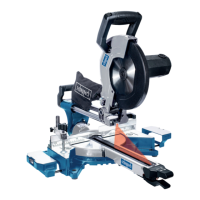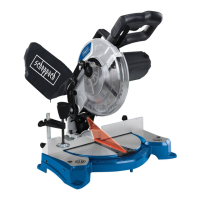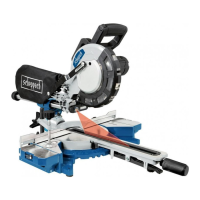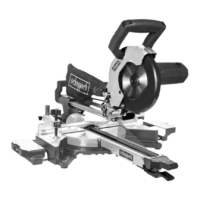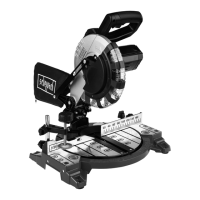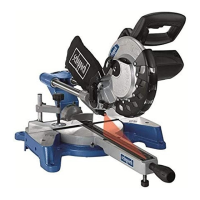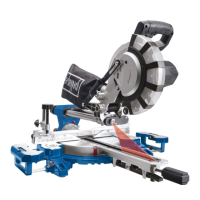www.scheppach.com / service@scheppach.com / +(49)-08223-4002-99 / +(49)-08223-4002-58
24
|
GB
– Do not use the electric tool for purposes for
which it is not intended. For example, do not
use handheld circular saws for the cutting of
branches or logs.
– Do not use the electric tool to cut rewood.
8 Wear suitable clothing
– Do not wear wide clothing or jewellery, which
can become entangled in moving parts.
– When working outdoors, anti-slip footwear is
recommended.
– Tie long hair back in a hair net.
9 Use protective equipment
– Wear protective goggles.
– Wear a mask when carrying out dust-creating
work.
10 Connect the dust extraction device if you will
be processing wood, materials similar to wood,
or plastics.
– If connections for dust extraction and a collect-
ing device are present, make sure that they are
connected and used properly.
– When processing wood, materials similar to
wood, and plastics operation in enclosed spac-
es is only permitted with the use of a suitable
extraction system.
11 Do not use the cable for purposes for which
it is not intended
– Do not use the cable to pull the plug out of the outlet.
Protect the cable from heat, oil and sharp
edges.
12 Secure the workpiece
– Use the clamping devices or a vice to hold the
workpiece in place. In this manner, it is held
more securely than with your hand.
– An additional support is necessary for long
workpieces (table, trestle, etc.) in order to pre-
vent the machine from tipping over.
– Always press the workpiece rmly against
the working plate and stop in order to prevent
bouncing and twisting of the workpiece.
13 Avoid abnormal posture
– Make sure that you have secure footing and
always maintain your balance.
– Avoid awkward hand positions in which a sud-
den slip could cause one or both hands to come
into contact with the saw blade.
14 Take care of your tools
– Keep cutting tools sharp and clean in order to
be able to work better and more safely.
– Follow the instructions for lubrication and for
tool replacement.
– Check the connection cable of the electric tool
regularly and have it replaced by a recognised
specialist when damaged.
– Check extension cables regularly and replace
them when damaged.
– Keep the handle dry, clean and free of oil and
grease.
15 Pull the plug out of the outlet
– Never remove loose splinters, chips or jammed
wood pieces from the running saw blade.
– During non-use of the electric tool or prior to
maintenance and when replacing tools such as
saw blades, bits, milling heads.
– When the saw blade is blocked due to abnormal
feed force during cutting, turn the machine off
and disconnect it from power supply. Remove
the work piece and ensure that the saw blade
runs free. Turn the machine on and start new
cutting operation with reduced feed force.
16 Do not leave a tool key inserted
– Before switching on, make sure that keys and
adjusting tools are removed.
17 Avoid inadvertent starting
– Make sure that the switch is switched off when
plugging the plug into an outlet.
18 Use extension cables for outdoors
– Only use approved and appropriately identied
extension cables for use outdoors.
– Only use cable reels in the unrolled state.
19 Remain attentive
– Pay attention to what you are doing. Remain
sensible when working. Do not use the electric
tool when you are distracted.
20 Check the electric tool for potential damage
– Protective devices and other parts must be
carefully inspected to ensure that they are fault-
free and function as intended prior to continued
use of the electric tool.
– Check whether the moving parts function fault-
lessly and do not jam or whether parts are dam-
aged. All parts must be correctly mounted and
all conditions must be fullled to ensure fault-
free operation of the electric tool.
– The moving protective hood may not be xed
in the open position.
– Damaged protective devices and parts must be
properly repaired or replaced by a recognised
workshop, insofar as nothing different is speci-
ed in the operating manual.
– Damaged switches must be replaced at a cus-
tomer service workshop.
– Do not use any faulty or damaged connection
cables.
– Do not use any electric tool on which the switch
cannot be switched on and off.
21 ATTENTION!
– Exercise elevated caution for double mitre cuts.
22 ATTENTION!
– The use of other insertion tools and other ac-
cessories can entail a risk of injury.

